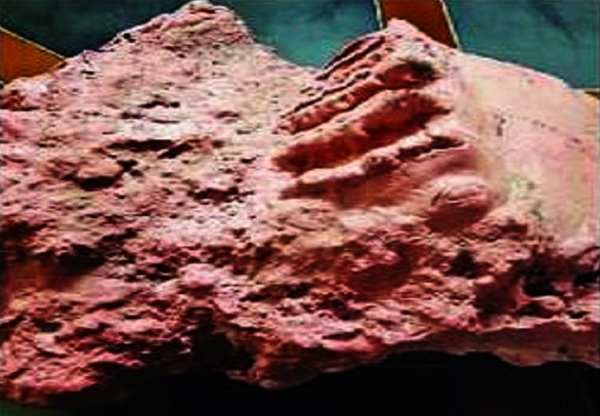Expert on Himalayan fossils from Kumaon University, who was approached by the Corbett Tiger Reserve administration, has confirmed that the fossils found in the park’s Bijrani range in May this year likely belong to an elephant species Elephas hysudricus, the ancestor of the present Asian elephant species Elephas Maximus and could be 0.2 to 2 million years old.
State’s 1st elephant fossil discovered
After MPS Bisht, director Uttarakhand Space and Application Centre (USAC), had found the fossils of an elephant-like creature inside Corbett’s Bijrani range during his visit in May this year, the Corbett administration first approached India’s noted palaeontologist Ashok Sahni, the man credited for placing India on the fossil map of the world.
“I sent photographs of the fossils to noted palaeontologist Ashok Sahni, who said the fossils were those of the elephants. As he was in the US, he said Corbett should contact Prof BS Kotlia from Kumaon University, who is an expert on the Himalayan fossils and has been studying them over the years.
“Then we contacted Prof Kotlia, who was very excited about the fossil find. He has now sent us a report on the fossils, confirming that they likely belong to elephant species that is the ancestor of the present species,” said Sanjiv Chaturvedi, who was the officiating director of the CTR till June 22.
In 2000, similar elephant fossils were found in Kashmir in a saffron field near Srinagar by some geology students who reported the find to the experts.
Kotlia’s report on the fossil find
Kotlia in his report submitted to CTR stated that based on the photographs, the species appear to be of Elephas hysudricus, ancestral to present day Elephas maximus that lived in the Indo-African continent during Pilio-Pleistocene time period (from 5 million onwards) and is now extinct. From India, similar fossils are discovered from Karewas of Kashmir, Siwalik of Jammu hills, Nadah, Chandigarh and Pinjor hillocks, he added.
The report further added that based on his researches in Ramnagar Siwalik, only Upper Siwalik sediments are exposed from Kosi Barrage to Garjia temple in Ramnagar and these date from 2 million to 0.2 million.
“The fossil bed from where these fossils have been found may fall somewhere in the lower part of the upper Siwalik and I deduce its age as younger than 2 million years ago,” he stated in his report.
“I have also urged authorities to allow extensive field trips to the site in Corbett as there could be more fossils of elephants and other mammals in the area. Generally, fossils of horse, deer and elephants are commonly found together in Siwalik strata,” the report added.
Permission for further excavation
Prof Kotlia said he has sought permission for carrying out further excavation in Corbett’s Bijrani, stressing there was the possibility of finding more fossils of elephants and mammalian species like horse and deer in Corbett. “I need to see the strata where the fossils were found and the fossils of this elephant to carry out a detailed analysis of these fossils and ascertain their exact identification and age,” he said, adding, “ This is the first elephant fossil find in Uttarakhand. Earlier elephant fossils have been found in Kashmir, Siwalik Himalayas in Punjab and Narmada valley.” “As this is a national park, I have sent a proposal for further excavation in the area to the seniors in my department,” said Chaturvedi.
Proposal for fossil museum
The Corbett administration has now sent a proposal to the principal chief conservator of forests (PCCF) and the chief wildlife warden that a fossil museum could be set up in the under-construction building outside Corbett’s Dhangadi gate, where fossils from across the state could be exhibited.
“As Corbett is currently getting around 2.8 lakh visitors, including over 7,000 foreign tourists annually, this fossil museum would attract a lot of visitors and help in promoting geo-tourism in the state,” said Chaturvedi.
This fossil find has significance as Corbett landscape is still a stronghold of elephants. Of 1,797 elephants in Uttarakhand as per last elephant census (2015), 1,035 elephants are found in Corbett landscape.
Fossils in the Himalayas
According to the Archaeological Survey of India (ASI), fossil remains from the Himalayan rocks date from 18.3 to 0.6 million years. Kalagarh area in Pauri district has also recorded stone-age man activities some 11 to 10 million years ago.
These include Sivapithecus indicus and Ramapithecus punjabicus. In 2017, a Dinosaur-like creature’s fossil was found during an excavation in Jaspur, 110 km away from Nainital.
Himalayan mountains which are around 40 million years old compared to peninsular mountains in India which are 1,500-2,500 million years old), have housed a rich animal life in the geological past evidenced by the discovery of fossils of amphibians, reptiles and mammals. The era of Shivalik ecosystem of rocks is called ‘Age of Mammals’ as it is the filtering zone for migration of animals from highlands to lowlands and vice-versa.
Source:HT
Image Courtesy: ToI
You may also like
-
New Heat-Based Approach To Cancer Treatment Can Reduce Chemotherapy Doses
-
Scientists Take A Major Step Towards Unification Of Classical & Quantum Gravity
-
India Graphene Engineering and Innovation Centre (IGEIC) Under the Vision of Viksit Bharat@2047 Launched
-
New High-Performance Gas Sensor can Monitor Low Level Nitrogen Oxides Pollution
-
Antidepressant Drug can be Repurposed for Treating Breast Cancer
